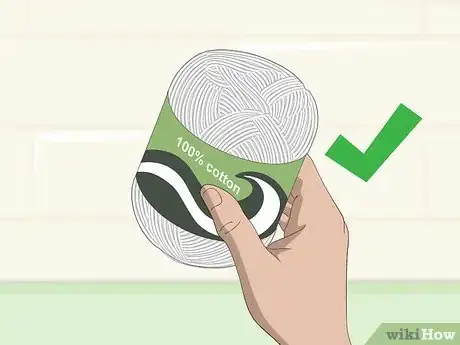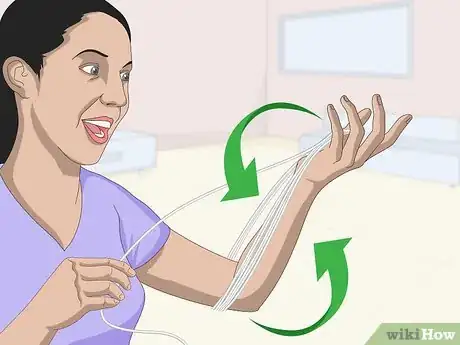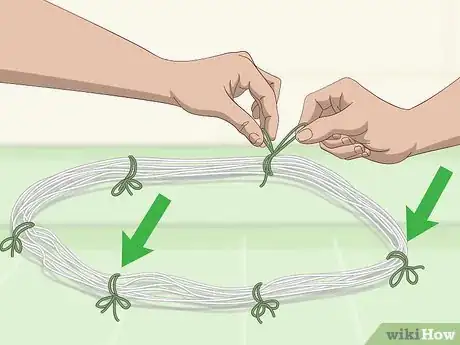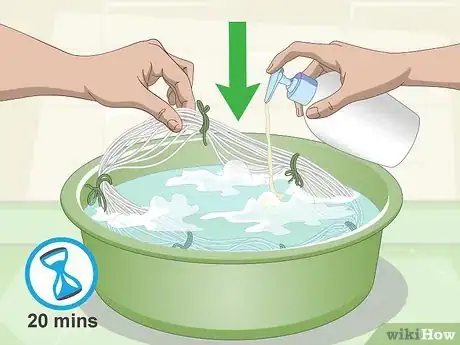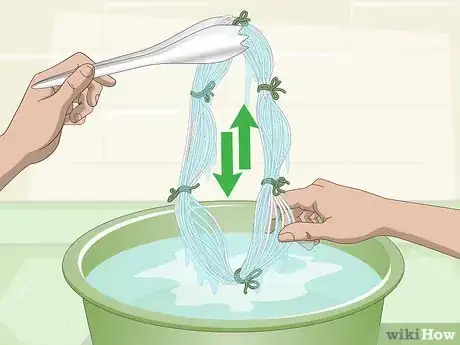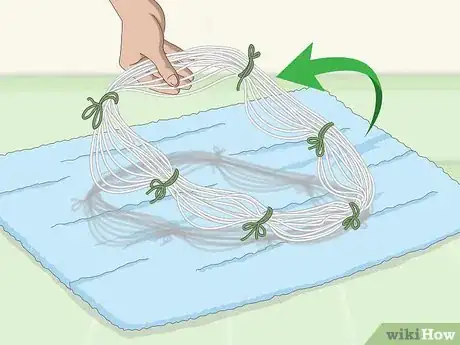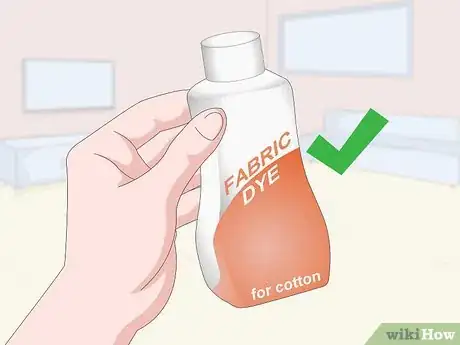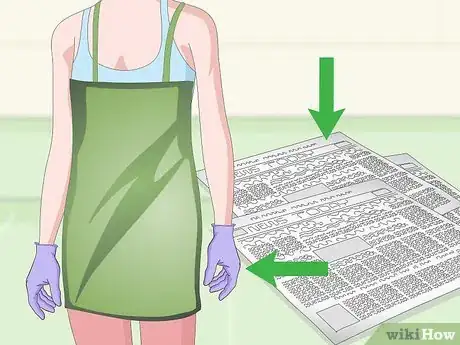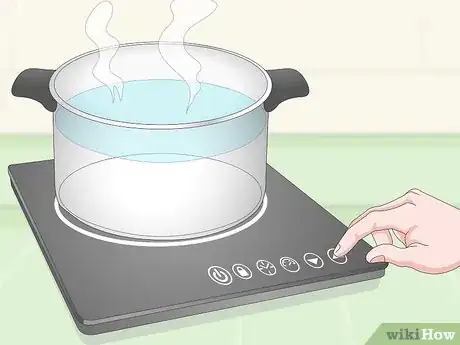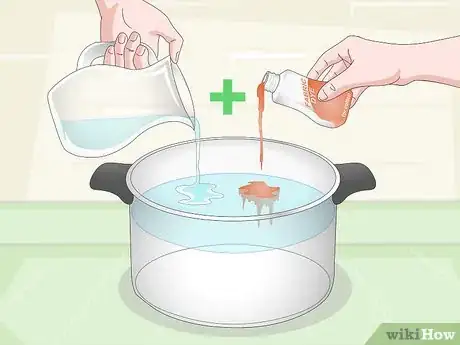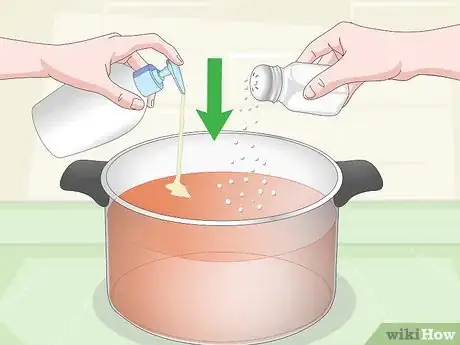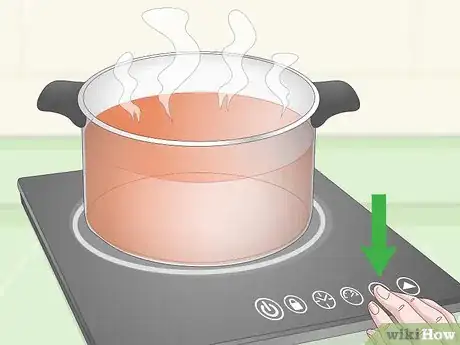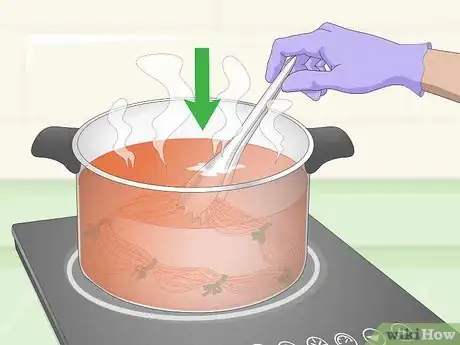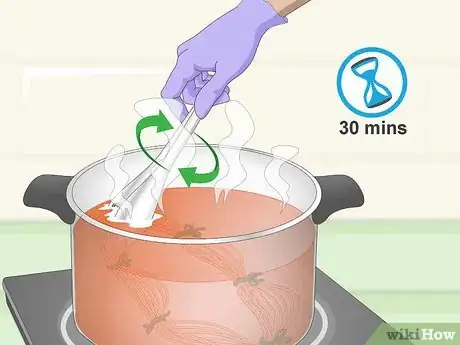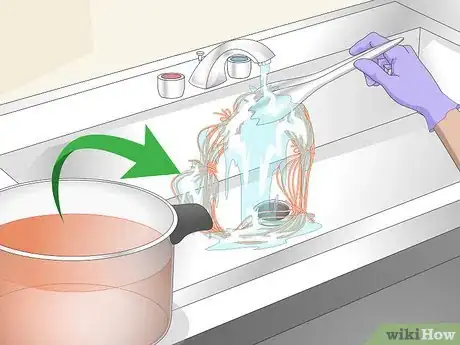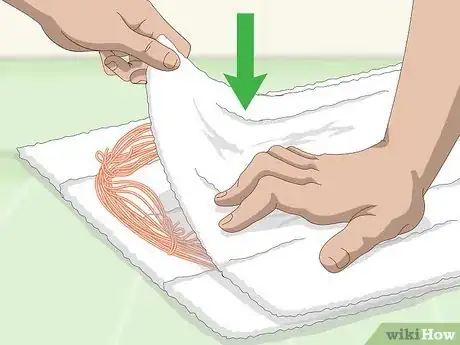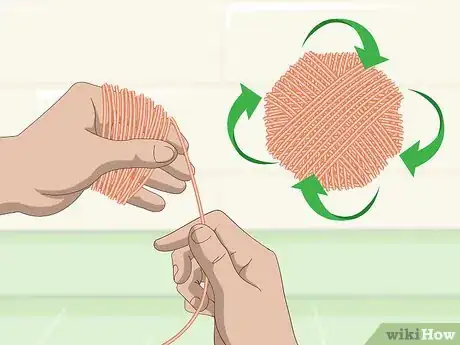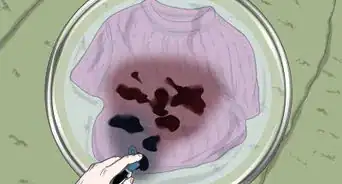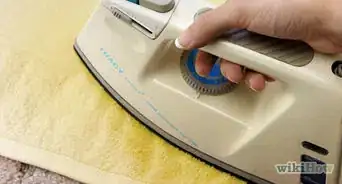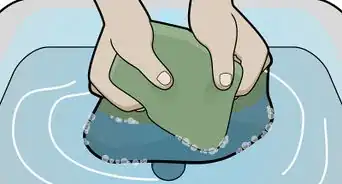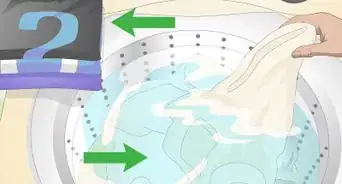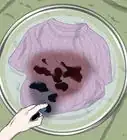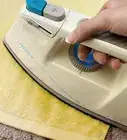This article was co-authored by wikiHow Staff. Our trained team of editors and researchers validate articles for accuracy and comprehensiveness. wikiHow's Content Management Team carefully monitors the work from our editorial staff to ensure that each article is backed by trusted research and meets our high quality standards.
This article has been viewed 72,281 times.
Learn more...
Dyeing yarn is easy, but how you prepare the dye depends on what sort of fiber the yarn is made from: acrylic, animal, or plant. Because cotton yarn is plant-based, you should prepare the dye the same way you would prepare dye for tie dyeing a t-shirt. Once you wrap the yarn and rinse it, you can dye it any color you want.
Steps
Preparing the Yarn
-
1Choose white, 100% cotton yarn. White will be the best, because it will give you the brightest results. If you want a more dusty, muted color, however, you could try gray instead. Most importantly, make sure that the yarn is made from 100% cotton. Most fabric, yarn, and craft stores will have a special section in their yarn aisle for cotton yarn.
- Some cotton yarn is mercerized and has a shiny finish. You can still dye this type of yarn, but be aware that it may take the dye differently from other types of cotton yarn.[1]
- Do not get yarn made from mixed materials, such as 50% cotton and 50% acrylic, or it may not dye evenly.
-
2Wind your yarn into a skein. Find the end of your yarn, and begin wrapping it around your hand and elbow; you can also wrap it around the back of a chair instead. Keep wrapping the yarn until you have used up the entire ball.
- Wrap the yarn tight enough so that it doesn't slide off, but loose enough so that it doesn't stretch or feel uncomfortable.
- Do not dye your yarn while it is still in a ball, or it won't dye evenly.
- If your yarn came twisted like a rope, simply untwist the "rope" until you have a loop of yarn instead.
Advertisement -
3Slip the yarn off your arm and secure it loosely with string. Slip the wrapped yarn off of your arm and set it down on a flat surface. Cut 6 pieces of string, then tie them loosely around the looped yarn to hold the strands together. Work your way around the loop; do not close the loop.
- If you want a tie dye effect, then tie the strings tighter.
-
4Soak the yarn for 20 minutes in warm water with some dish soap. Fill a pot or basin with enough warm water to cover your yarn. Add 1 or 2 pumps of liquid dish soap and stir to combine. Add your yarn into the water, and press down on it to submerge it. Leave it there for 20 minutes.
- Yarn often contains coatings, such as wax, which can prevent the dye from adhering.
- Don't be alarmed if the water changes color to brown. This is simply the residue from the yarn.[2]
-
5Rinse the yarn until the water runs clear. Lift the yarn out of the pot with a pair of tongs. Rinse the yarn under cool, running water to remove any soap and residue. Keep rinsing the yarn until the water runs clear.
- Wiggle your fingers through the strands to help separate them. This will ensure that the fresh water reaches them too.
- Do not use the same tongs you'd use for cooking. Reserve these tongs only for dyeing.
-
6Let the yarn dry until it is no longer dripping. Once the water runs clear, gently squeeze the excess water from the yarn. Spread the yarn out on a clean towel and leave it there until it dries partway. You want the yarn to still be somewhat damp.
Preparing the Dye
-
1Choose fabric dye meant for cotton fabric. Plain old fabric dye from the fabric store or craft store (i.e. RIT dye) will work the best. It is the same stuff you'd use on t-shirts and other cotton garments.
- Do not use dye made for wool or synthetic materials. It won't react the same way to cotton yarn.
-
2Protect your work space, skin, and clothing. Even through you are working with fabric dye, it can still stain other things, such as counters. Cover your counter with newspaper or a plastic bag. Put an apron or clothing you won't mind accidentally staining. Lastly, pull on a pair of plastic gloves.
-
3Bring a pot of water to a simmer. Fill your pot with enough water to completely cover the yarn. Bring the water to a simmer over low to medium-low heat. Do not let the water boil.[3]
- A crockpot would be an even better idea because the heat is slow and steady.
- Do not use the same crockpot or cooking pot that you'd use for food. Reserve these pots for dyeing and crafts only.
-
4Fill your pot with water and dye. How much water and dye you use depends on the brand of the dye and how much yarn you are dyeing. In most cases, you will need 3 quarts (2.8 L) of water and 1/2 cup (120mL) of dye. Refer to the label on the dye for more specific amounts.
- Use half the dye you need for a lighter shade. For a darker shade, you may have to add a drop of a darker dye color.
- Most dye proportions are based on weight. Check the label that came with your yarn to find out how much you have.
-
5Add some salt and dish soap. Again, how much salt and dish soap you use depends on how much water and yarn you used. In most cases, you will need 1/2 cup (150 g) of salt for every 3 quarts (2.8 L) of water. Add 1 squirt of liquid dish soap, and stir.
-
6Bring the water to a simmer. Turn the heat up on the stove to low or medium-low. Allow the water to come to a simmer. Do not let it boil.
- If you are using a crockpot, turn the heat up to high.
Dyeing the Yarn
-
1Submerge the yarn in the dye bath. Place the yarn into the water. Press it down with a metal spoon, tongs, or wooden chopsticks. Make sure that the yarn is submerged as much as possible.
- Do not reuse the spoon, tongs, or chopsticks for cooking. Reserve them for arts and crafts.
- If you are using chopsticks, be aware that this will permanently stain them. Consider using disposable ones instead.
-
2Allow the yarn to dye for 30 minutes, stirring it occasionally. Parts of the yarn will float to the surface, so you'll want to push them down--otherwise, they won't dye evenly. Every so often, use your metal spoon, tongs, or chopsticks to gently shift the yarn around. A simple prod and stir is all you need.[4]
- Do not stir the yarn like you'd stir soup or cake batter, or you'll risk tangling the yarn.
- If you are using a crockpot, cover the pot with a lid, and let it cook. You will still need to stir the yarn.
-
3Take the yarn out and rinse it until the water runs clear. Lift the yarn out with a pair of metal tongs. Rinse the yarn under warm, running water. Keep rinsing the yarn until the water runs clear, slowly lowering the temperature as you do so.[5]
- Wiggle the strands between your fingers so ensure that the fresh water reaches them.
-
4Squeeze the yarn in a towel, then set it out to dry. Once the water runs clear, squeeze the excess water from the yarn. Place the yarn on top of an old towel, close to the end. Wrap the towel around the yarn into a tight bundle, then press down on it to soak up any excess water. Unwrap the yarn, then leave it on the towel to dry.
-
5Roll the yarn into a ball. Cut the pieces of string holding the yarn together first. Wrap the yarn around your fingers 25 to 50 times, then slide it off. Wrap the yarn across the loop another 25 to 50 times. Continue wrapping it, switching direction often: top-to-bottom, side-to-side, and diagonally.
Community Q&A
-
QuestionCan I spray bleach on natural cotton yarn to lighten it?
 T. ChinsenTop AnswererBleach can whiten cotton yarn. Spraying, however, can result in uneven application of the bleach, with areas turning out not as white due to insufficient penetration. The end result could be streaks or bands of colors.
T. ChinsenTop AnswererBleach can whiten cotton yarn. Spraying, however, can result in uneven application of the bleach, with areas turning out not as white due to insufficient penetration. The end result could be streaks or bands of colors. -
QuestionIs black tea a good solution to dye white cotton serviettes?
 T. ChinsenTop AnswererAny tea will dye white cotton to an off white shade or sepia if it is a particularly dark tea. Teas release tannins that create the coloration in the cotton. Synthetic fibers generally do not dye well as the fibers are not porous like natural cotton.
T. ChinsenTop AnswererAny tea will dye white cotton to an off white shade or sepia if it is a particularly dark tea. Teas release tannins that create the coloration in the cotton. Synthetic fibers generally do not dye well as the fibers are not porous like natural cotton.
Warnings
- Do not reuse any pots or utensils for cooking. Reserve these for dyeing and crafts.⧼thumbs_response⧽
Things You'll Need
- Cotton yarn
- Rubber gloves
- Pot or basin
- Water
- Dish soap
- Fabric dye
- Salt
- Old towels
References
- ↑ https://www.craftsy.com/blog/2014/06/hand-dyeing-cotton-yarn/
- ↑ https://www.craftsy.com/blog/2014/06/hand-dyeing-cotton-yarn/
- ↑ https://www.craftsy.com/blog/2014/06/hand-dyeing-cotton-yarn/
- ↑ https://www.craftsy.com/blog/2014/06/hand-dyeing-cotton-yarn/
- ↑ https://www.craftsy.com/blog/2014/06/hand-dyeing-cotton-yarn/
- ↑ https://www.allfreeknitting.com/video-basics/how-to-tie-dye-cotton-yarn
About This Article
To dye cotton yarn, start by unwrapping the yarn and winding it into a long, loose skein. Next, soak the yarn for 20 minutes in warm water and 2 pumps of dish soap, rinse it well, and dry it until it's no longer dripping. Then, bring a large pot of water to a boil and add the fabric dye, along with a squirt of dish soap and 1/2 cup of salt for every 3 quarts of water. Allow the yarn to sit for 30 minutes, gently stirring it every few minutes so the dye takes evenly. Finally, remove the yarn from the pot and rinse it until the water runs clear, then let it dry. For tips on how to adjust your dye colors to get darker or lighter yarn, read on!
